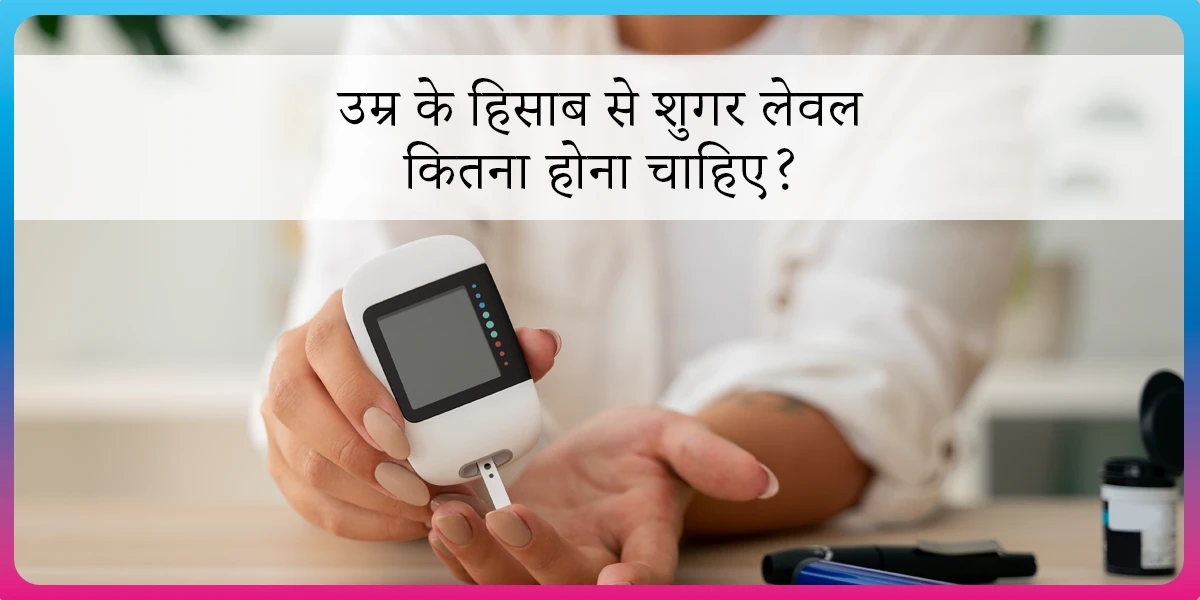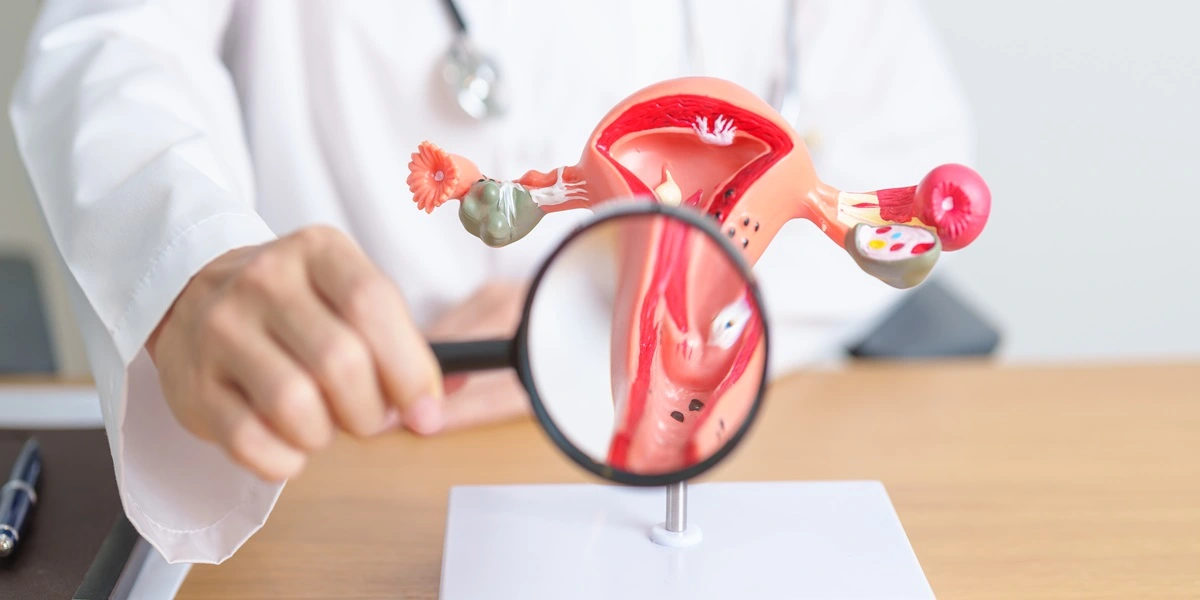Understanding Fasting & Post-Prandial Blood Sugar Levels in Diabetes
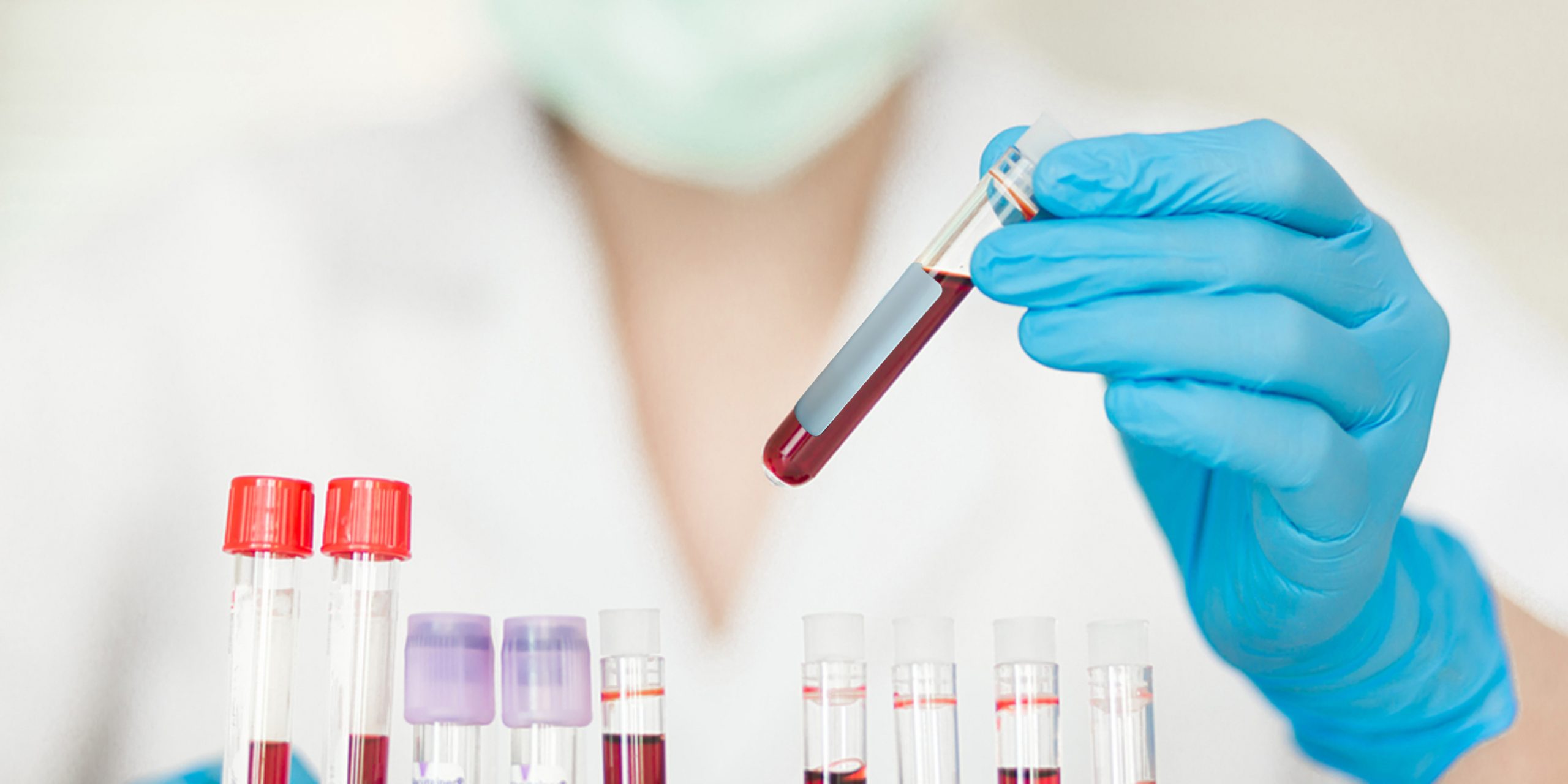
If you have ever gone to get your blood sugar levels checked, you may have heard two phrases- fasting blood sugar (FBS) and post-prandial blood sugar (PPBS). Fasting and post-prandial blood sugar levels are vital parameters – not only to diagnose diabetes but also for those trying to keep their blood glucose levels in check.
This value gives a deeper insight into a person’s blood sugar control and enables diabetologists to determine the best possible treatment and management plan for each individual.
One of the first things to know is what exactly fasting, and post-prandial blood sugar levels are.
What is Fasting Glucose?
A fasting blood sugar test measures the blood sugar levels after an overnight fast of 8 to 12 hours. So, most fasting blood glucose tests are scheduled in the morning.

In case of any abnormal result, you can repeat this test on a separate day to confirm the diagnosis.
Factors Influencing Fasting Blood Glucose
Your fasting blood glucose levels primarily depend upon three factors:
- The contents of your last meal
- Size of meal
- Your body’s ability to produce insulin and use it effectively
- Timing of your last meal
- Duration of fasting
- Sleep duration and quality
- Carbohydrate content of your meal
- Medications (if you are taking any)
High fasting blood sugar levels indicate that your body is unable to manage and lower blood sugar levels, which may be due to insulin resistance, inadequate insulin production or both. Very low fasting blood sugar indicates that your diabetes medications are lowering your blood sugar levels too much.
One of the main causes of high fasting blood sugar levels in the morning (in people with diabetes) is the dawn phenomenon. According to this:
In the early morning hours, hormones like cortisol and growth hormone stimulate the liver to produce glucose. This ensures you have energy that helps you wake up. To produce glucose, the insulin-producing cells in the pancreas are stimulated.
However, if you have diabetes, your pancreas may not make enough insulin, or insulin resistance may be high to counter the rise in blood sugar. As a result, you wake up with high blood sugar levels.
Relationship between Fasting Blood Glucose and HbA1c Levels
Your fasting blood glucose levels measure the glucose levels at a single or specific time. For this reason, these results are more likely to be influenced by your daily or weekly actions. Your HbA1c levels, on the other hand, are an average reading of three months.
So, if your HbA1c is normal, but fasting glucose is higher than normal, it may be due to lack of sleep, stress or eating a high carbohydrate or sugar-laden meal the night before the test. In this case, you may be advised to repeat the test on another day.
The HbA1C test is also considered the main test for the early detection of abnormal blood glucose levels. This test detects your average blood sugar control over the past 2 to 3 months.
To know your chances of Diabetes reversal, take the Diabetes Reversal TestDiabetes Reversal
Calculator
Understanding Postprandial (PP) Glucose Levels
On the other hand, the post-prandial blood sugar test measures the blood glucose levels two hours after eating a meal. PP can be two hours after breakfast, lunch (POL) or dinner (POD) while monitoring your blood sugar levels.
A post-prandial test is usually done to evaluate how your body responds to the sugar and starch that you eat in a meal. When you eat a meal, the food gets digested in your stomach, and the blood glucose or blood sugar rises sharply.
In response to this rise in blood sugar, your pancreas produces insulin to move these sugars into muscles and other tissues. Within 2 hours of your meal, your blood sugar levels should return to normal.
However, if your post-prandial blood glucose levels are high (also known as Impaired Glucose tolerance or IGT), you have diabetes or prediabetes.
Some studies have shown that the order of food you consume in your meal can affect your post-prandial blood glucose levels.


Fasting and postprandial blood sugar test results may vary based on age, gender and health history. There may be a slight difference in the values given by different labs. Fasting and postprandial blood sugar tests are done by collecting a simple blood sample from a vein in your hand.
Since blood glucose levels vary during a 24-hr period and from day to day in people with diabetes, your doctor may recommend an HbA1c test, an indicator of long-term glycemic control.
Factors Influencing Postprandial Blood Glucose Levels
A few factors may affect your post-prandial blood glucose levels, such as:
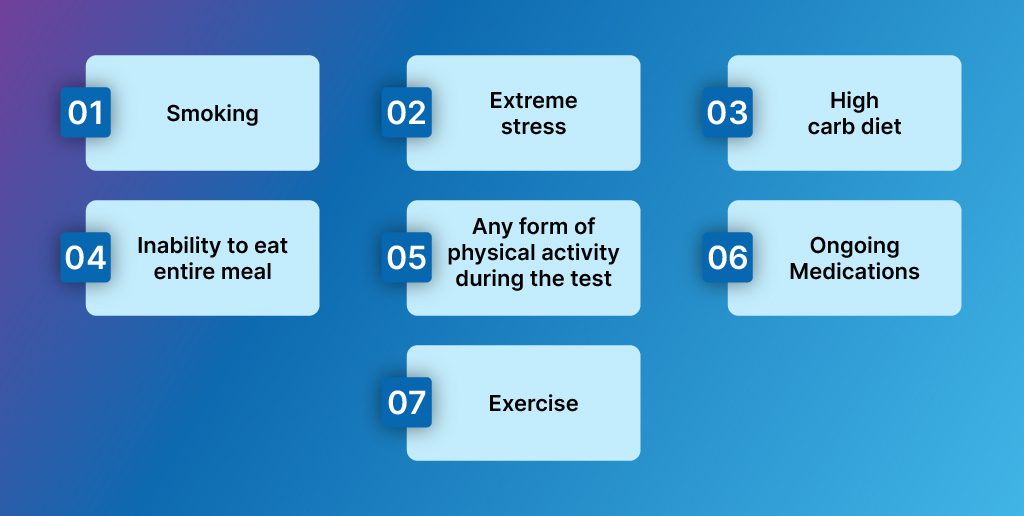

Target Fasting and Postprandial Blood Sugar Levels for People with Diabetes
Several studies have been performed to understand the relationship between fasting blood sugar, postprandial blood sugar and HbA1c in people with diabetes. The American Diabetes Association (ADA) recommends that people with diabetes must try to achieve:
- Fasting blood glucose levels of 90 to 130 mg/dL
- Peak postprandial blood glucose of less than 180 mg/dL
- HbA1c of <7%
Compared to fasting blood sugar levels, post-prandial and HbA1c levels are a more reliable indicator of blood sugar control in people with diabetes.
Why should one monitor their Blood Sugar Levels?
People with prediabetes and diabetes need to test their blood sugar levels regularly. Doing so helps in several ways:
- Helps you and your doctor monitor how your blood sugar levels rise or fall based on your lifestyle and dietary factors
- Enables your doctor to understand if your medications are helpful in bringing your blood sugar levels under control
- Helps prevent diabetes-related complications early on
- It also helps individuals understand how effective their self-care is and what they need to do for better blood sugar control.
How to get Your Fasting and Post Prandial Blood Sugar checked?
There are three ways to get a fasting and postprandial blood sugar test done: through a diagnostic lab, using Continuous Glucose Monitoring (CGM), and through Self-Monitoring of Blood Glucose (SMBG). Here’s what you should keep in mind for each method:
Diagnostic Lab
- Appointment: Check with the lab for any specific instructions or preparations required before the test.
- Fasting period: Follow the recommended fasting period, typically around 8 hours without food or drink (except water) before the test. Adhering to the fasting guidelines is crucial to obtain accurate fasting blood sugar results.
- Medications: Consult with your doctor to determine whether you should take your regular diabetes medications before the test or if any adjustments are necessary.
- Proper documentation: Make sure to carry any relevant medical documents or prescriptions related to your diabetes management, as the lab may require them for reference.
Continuous Glucose Monitoring (CGM)
CGM involves wearing a small sensor that continuously measures glucose levels in the interstitial fluid beneath the skin. The sensor sends the data wirelessly to a receiver or a smartphone app for real-time monitoring.
- Device placement: Consult with your doctor to correctly place the CGM device on your body. They will guide you on the appropriate location, such as the upper arm or abdomen.
- Calibration: Proper calibration of the device ensures accurate blood sugar readings.
- Data analysis: Regularly review and analyze the CGM data, paying attention to fasting and postprandial periods. Look for patterns, trends, and any significant fluctuations in blood sugar levels.
- Collaboration with your Diabetes Management team: When you enroll with Fitterfly’s Diabetes Care Programs, we use CGM sensor monitoring as part of our approach to diabetes management. By using CGM, Fitterfly members can gain real-time insights into their blood sugar levels and their personalized glycemic response. This information is then used to create customized meal plans that help individuals keep their blood sugar levels in check.
Self-monitoring of Blood Glucose (SMBG)
- Glucometer usage: In this way of monitoring, a glucometer which is a portable blood glucose monitoring device is used to measure your blood sugar levels at home. Ensure that you have a reliable and accurate glucometer.
- Test strips and lancets: Make sure you have an adequate supply of test strips and lancets for blood sampling. Follow the instructions provided by the manufacturer for proper use and disposal of these items.
- Pre- and post-meal testing: Follow the recommended guidelines for timing your fasting and postprandial blood sugar measurements. Typically, fasting levels are checked in the morning before breakfast, while postprandial levels are measured about 2 hours after starting a meal.
- Recording and tracking: Maintain a record of your blood sugar readings, noting the date, time, and any relevant details such as meal composition, physical activity, or medication intake. This record can help identify patterns and facilitate discussions with your doctor. These readings are usually higher than those given by lab tests.
REVERSED Diabetes in 3 months


5.7%
Happy members
EMI
Guarantee
4.8/5
Diabetes Prime Program
Some Other Methods for Monitoring Blood Sugar Levels in Diabetes
Besides fasting and postprandial blood glucose, there are several ways to keep a tab on your blood sugar levels, such as:
1. HbA1C
An HbA1c test gives an average of your blood sugar levels over the past 2-3 months. Glucose in the blood attaches to haemoglobin (the blood pigment). As your blood glucose levels rise, more of your haemoglobin gets coated with the glucose.
The HbA1c test measures the percentage of red blood cells that have glucose-coated haemoglobin. This test is also called the glycated haemoglobin test.
2. Random blood glucose levels
Unlike fasting and post-prandial blood sugar tests that have a specific time for testing, a random blood sugar test can be taken at any time during the day, irrespective of the last meal.
A random blood glucose reading of 200 mg/dL or higher indicates you have diabetes. However, these readings must be confirmed with a fasting and post-prandial blood glucose and HbA1c tests
3. Oral Glucose Tolerance Test (OGTT)
An oral glucose tolerance test or OGTT is used to diagnose diabetes and measures the body’s ability to utilise blood sugar. This test is done after fasting by consuming 75 gm of anhydrous glucose dissolved in water and the blood samples are collected at intervals of 1 hr, 2 hr and 3 hrs. A fasting blood glucose level is also taken before drinking the glucose solution.
Generally, the normal GTT result is less than 140 milligrams per deciliter (mg/dl) after 2 hours. However, if your blood glucose level is higher than 140 mg/dl, you may have diabetes.
Things to keep in mind before getting a Fasting and Post Prandial Blood Sugar test Done
Before measuring fasting blood sugar levels:
- Overnight fast: Ensure that you have fasted for at least 8 hours prior to the test. This means no food or drinks, except water, should be consumed during this time.
- Medications: Check with your healthcare provider whether you should take your regular diabetes medications before the fasting blood sugar test or if any adjustments need to be made.
- Hydration: Drink enough water to stay hydrated, as dehydration can affect blood sugar levels. However, avoid any other beverages or foods during the fasting period.
- Avoid strenuous exercise: Refrain from engaging in intense physical activity before the test, as it may affect your blood sugar levels and lead to inaccurate results.
- Stick to your routine: Try to maintain your regular lifestyle and sleep pattern before the test, as disruptions in routine can influence blood sugar levels.
When measuring post-prandial blood sugar levels:
- Time frame: Measure your blood sugar levels 2 hours after starting a meal, as this is the commonly recommended time frame to assess post-prandial glucose response.
- Standard meal: Consume a standard meal that reflects your usual eating habits, rather than an exceptionally large or small meal. This will provide a more accurate representation of your body’s response to typical food intake.
- Carbohydrate content: Be mindful of the carbohydrate content of the meal, as carbohydrates have the most significant impact on blood sugar levels. Try to keep the meal consistent in terms of carbohydrate composition.
- Record meal details: Note down the details of the meal, including the types of food consumed and portion sizes. This information can help you and your doctor make necessary adjustments to your diet if needed.
- Avoid exercise: Refrain from engaging in physical activity immediately after the meal, as exercise can affect blood sugar levels. Instead, wait until after you have measured your post-prandial blood sugar levels.
Strategies for Managing Fasting Glucose Levels
Maintaining your fasting blood sugar levels within the normal range is important. Here are a few tips that may be useful:
- Eat an early dinner to allow sufficient time for digestion before bedtime
- Control the carbohydrate content in your meal
- A post-dinner walk is beneficial
Strategies for Management of Postprandial Glucose Levels
Lifestyle management and dietary changes can reduce after-meal blood sugar spikes. Here are some ways to maintain your post-prandial blood sugar levels within the normal range:
- Limit your consumption of foods that have a high glycemic index
- Eat more fibre-rich foods
- Control the carbohydrate content in your meals
- Smart food pairings
- Reduce your portion sizes and practice portion control
- A 30-minute post-meal brisk walk improves glycemic response after meals
- Medications can also help control post-prandial glucose levels (alpha-glucosidase inhibitors)
- Achieve weight loss if you are overweight and maintain it within the normal range
- Exercise regularly
- Ensure good sleep quality
- Effective stress management
The Effects of Uncontrolled Glucose Levels
Uncontrolled blood sugar levels can cause a wide range of symptoms.
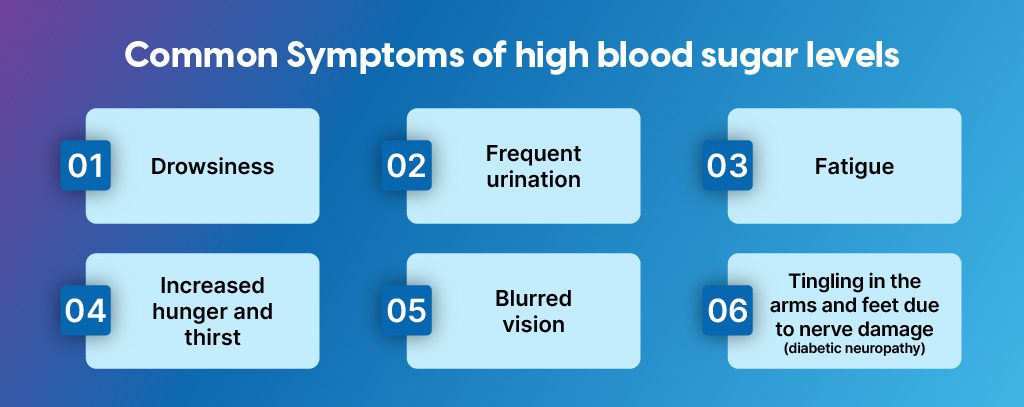

The symptoms of low blood sugar (hypoglycemia) occur when people with diabetes have not had enough food or have excess insulin in their bodies.
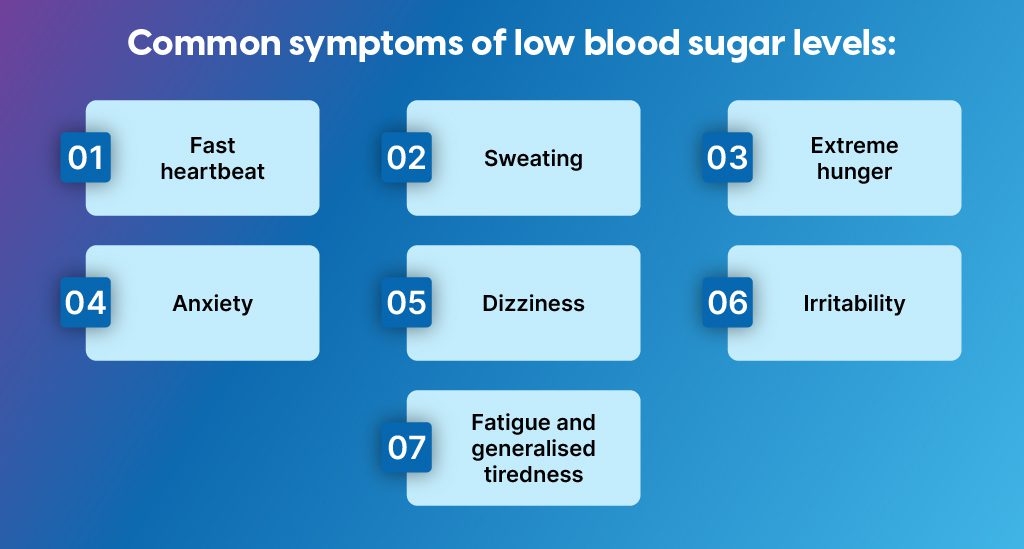

Complications arising in Diabetes when Blood Sugar levels are high
High fasting and post-prandial blood sugar levels can cause several complications if not managed in time. A few of these include:
- Kidney damage (nephropathy)/Eye problems
- Liver damage
- Cardiovascular disorders
- Foot problems
- Nerve damage (neuropathy)
A few acute or short-term complications of diabetes that may develop if high blood sugar levels are not managed in time are:
- Diabetic ketoacidosis (DKA)
- Hyperosmolar hyperglycemic state
FitterTake
To achieve effective blood sugar control, it is crucial to work with a comprehensive team of experts like those at Fitterfly. At Fitterfly, we specialize in developing personalized diabetes management plans.
Our approach involves utilizing CGM monitoring and PGR (Personalized Glycemic Response) to create customized meal plans tailored to your specific needs. By analyzing your blood sugar levels, we can suggest the most suitable diet to keep them in check.
Monitoring your fasting, post-prandial blood sugar, and HbA1c levels on a regular basis provides valuable insights into your body’s blood sugar control. It is essential to stay aware of these measurements for effective management.
At Fitterfly, our Diabetes Care Program like Fitterfy Diabetes Prime has been carefully designed by a comprehensive team consisting of a nutrition coach, a physiotherapy coach, and a success coach. Our program revolves around four pillars of diabetes management:
- Right diet: We help you develop a suitable diet plan to maintain optimal blood sugar levels.
- Adequate and the right form of exercise: Our experts guide you on incorporating exercise routines that are appropriate for your condition.
- Adequate sleep: We emphasize the importance of quality sleep in diabetes management and provide guidance to improve your sleep habits.
- Effective stress management: Our program includes strategies to effectively manage stress, as it can significantly impact blood sugar control.
If you are living with diabetes or prediabetes and wish to gain better control over your blood sugar levels, we encourage you to sign up for Fitterfly’s Diabetes Care Program. To begin your journey, book a consultation with one of our expert Program Advisors!
This blog provides general information for educational and informational purposes only and shouldn't be seen as professional advice.
Frequently Asked Questions
Which is more important- fasting or post-prandial blood sugar levels?
Both fasting and post-prandial blood sugar levels are important indicators of your overall blood sugar control. Fasting blood sugar measures your glucose level after an overnight fast, while post-prandial blood sugar reflects your glucose level after a meal. Both values provide crucial information for managing diabetes, and it's essential to monitor and control both to maintain healthy blood sugar levels throughout the day. So, we should not compare the two.
What is considered a normal level of post-prandial blood glucose level?
For people without diabetes, blood sugar levels below 140mg/dL are considered normal. For people with diabetes, levels between 140mg/dL and 180mg/dL are normal.
Can you drink water before a post-prandial blood sugar level test?
Yes, you can drink water before a post-prandial blood sugar test.
When should you check your post-prandial blood sugar levels?
You must check your post-prandial blood sugar test two hours after a meal. The American Diabetes Association (ADA) recommends undergoing a fasting and post-prandial test for better interpretation of your blood sugar control.
I did a fasting and post-prandial blood glucose test, do I still need to check my HbA1c levels?
Yes, getting an HbA1c test allows your doctor to evaluate your average blood glucose levels over the past 2 to 3 months.
Can I just do a fasting blood sugar test?
Comprehensive analysis with fasting, post-prandial, and HbA1c gives your doctor better clarity on how your blood sugar levels vary with fasting, on eating a meal and over the last couple of months.
Will my fasting blood sugar levels be affected if I walk to the lab for my test?
Any physical activity or exercise done on an empty stomach can cause a sugar spike. So, it is recommended to avoid walking to the lab for your fasting blood sugar level test.
I had a late dinner. Shall I do a fasting blood sugar test the next morning?
For a fasting blood sugar test, you must fast for a minimum of 8 hours. So, if you have had a late dinner, schedule your test 8 hours later.














